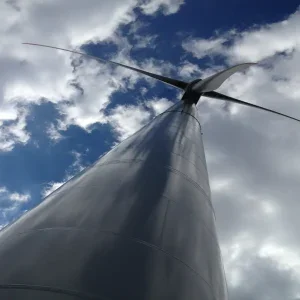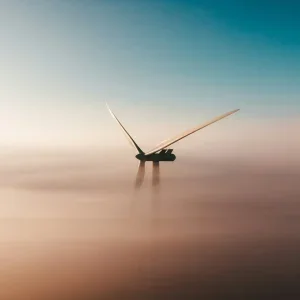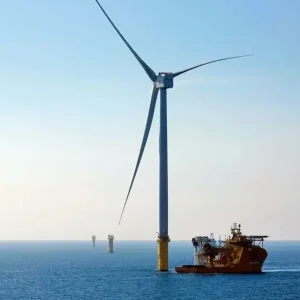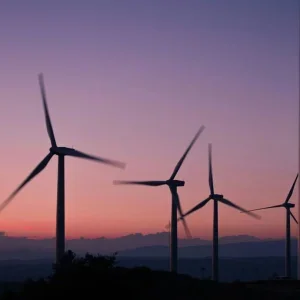Turbine manufacturers may be targeting slower winds, but the rate of development is picking up pace. Earlier this year, Gamesa announced the installation of its G114 2MW prototype in Navarre, northern Spain. Designed for low wind speeds, the G114 boasts a 114m rotor diameter and a record low specific power rating of just 196W/m2. What’s more, it produces 20% more energy than its predecessor, the G97 2MW.
"We decided to go for the best capacity factor and the best cost of energy in the market," says Antonio de la Torre Quiralte, Gamesa’s product development director. "It’s the most competitive turbine in the marketplace for 6m/s and upwards, and the capacity factor is higher than any of our competitors’."
The low-wind-speed market was born just five years ago, when Vestas launched the V100 1.8MW turbine. A development on the 2MW V80 and V90 models, it had an enlarged 100m rotor diameter and reduced specific power rating of just 223W/m2. The following year, GE introduced a 1.6MW turbine, also with a 100m rotor diameter, giving an even lower 204MW/m2 specific power rating.
Though many at the time thought this too extreme, the model was a huge success and GE reportedly sold out within months. Since then, a number of manufacturers have jumped on the low wind speed bandwagon.
For turbine producers and utility firms, the primary attraction of a high rotor diameter combined with a low megawatt rating is that capacity factors are significantly higher: the turbine is taking more wind from a larger area to power a smaller generator.
Predictive power
This makes it much easier for grid operators to predict power generation. It also means there is less of a gap between what the turbine’s components are capable of, and how they’re required to perform. Manufacturers can then design the parts more cost-efficiently, reducing the overall energy price.
Gamesa’s G114 has set a new standard for the low wind speed market, offering a capacity factor of 46% at 6m/s. According to Quiralte, this then jumps to 49% at 7.5mps, the average annual wind speed for the IEC Class IIIA, to which the G114 belongs.
"Both these figures surpass the nearest market competition," says Quiralte. "Moreover, the G114’s cost of energy production is 5-6% lower than anything else currently available at the 6m/s speed."
The G114’s final design was the result of five years of painstaking research by Gamesa, including the development of two new airfoils that cut aerodynamic noise and ultimately reduce the energy cost.
Both constructed to match structural efficiencies with high annual production and low loads, the mid-span airfoil is extremely thick and has a curtailed lift curve, while the blade root design has a high lift profile. The firm also spent three years researching and experimenting with glass fibre as a blade material, before settling on a final formula.
Glass act
"We used to be fully devoted to carbon fibre: we loved its lightness and strength," says Quiralte. "Recent market conditions have meant it’s too expensive to use this material and achieve a good cost of energy, though, so between 2009 and 2012, we invested a great deal of money in looking at the characteristics of glass-fibre materials and structures. We had to consider how the airfoils would fit with this sort of structure, and what the capital expenditure for manufacturing glass fibre would be."
Gamesa also had to ensure the blades had sufficient structural strength. This eventually resulted in the development of a sophisticated glass fibre cellular framework to handle frontal turbulence, absorbing the force that travels up the blades and through the turbine’s various components into the tower.
"Some of our competitors use a mix of carbon and fibre in the blade to deal with this. Some are using the typical beam," explains Quiralte. "We’re not using any sort of beam: we’re relying on the glass-fibre structure."
"We do see the opportunity to embed certain carbon-fibre structures in the future. But for the moment, and for the G114, our conclusion has been that glass fibre has allowed us to achieve a very competitive cost of energy."
This price efficiency is partly a result of the material’s relatively low upfront cost in comparison with the lighter carbon fibre. It is also due, somewhat ironically, to the technical limitations of today’s blade manufacturers.
"If you look at the industrial facilities that are available around the world, there aren’t very many blade OEMs capable of properly managing carbon fibre solutions," notes Quiralte. "But there’s an abundance of firms that can meet our requirements if we’re working with glass fibre.
"It also helps to be able to choose third-party manufacturers that are close to our natural markets: that helps bring down the cost of energy."
While such price reductions are welcome, however, the G114’s biggest contribution to energy cost-efficiency lies in its potential to open up many of the sites currently deemed unviable for development.
"There are a number of locations that have had all the necessary permits, but no feasible business case, because the wind speed simply isn’t high enough," says Quiralte. "With the extremely high capacity factor offered by the G114, however, these projects become a possibility."
City farms
Crucially, many potential low-wind- speed sites are also close to urban areas. If these were to become viable new locations for wind farms, it would eliminate the need for the expensive energy storage solutions that are so often seen as a barrier to wind energy expansion: the energy could simply be consumed by the immediate population. This was the model used for power plants in the early days of electricity: they were built inside the cities, where demand was strongest.
The G114’s high capacity factor also means the difference between average and rated power is much smaller than for many existing turbines, so transmission capacity can be geared more accurately, requiring less- expensive components.
What’s more, the increased power predictability makes turbines like the G114 significantly easier to integrate into the grid, again cutting out the need for expensive energy storage, even in non-urban areas. To say that the G114 will singlehandedly open all these doors would undoubtedly be wishful thinking.
Nevertheless, Gamesa’s latest model has pushed low wind speed turbines into new realms of cost-efficiency. The world’s approach to wind energy will not change overnight, but turbines like this are inching it ever closer.






